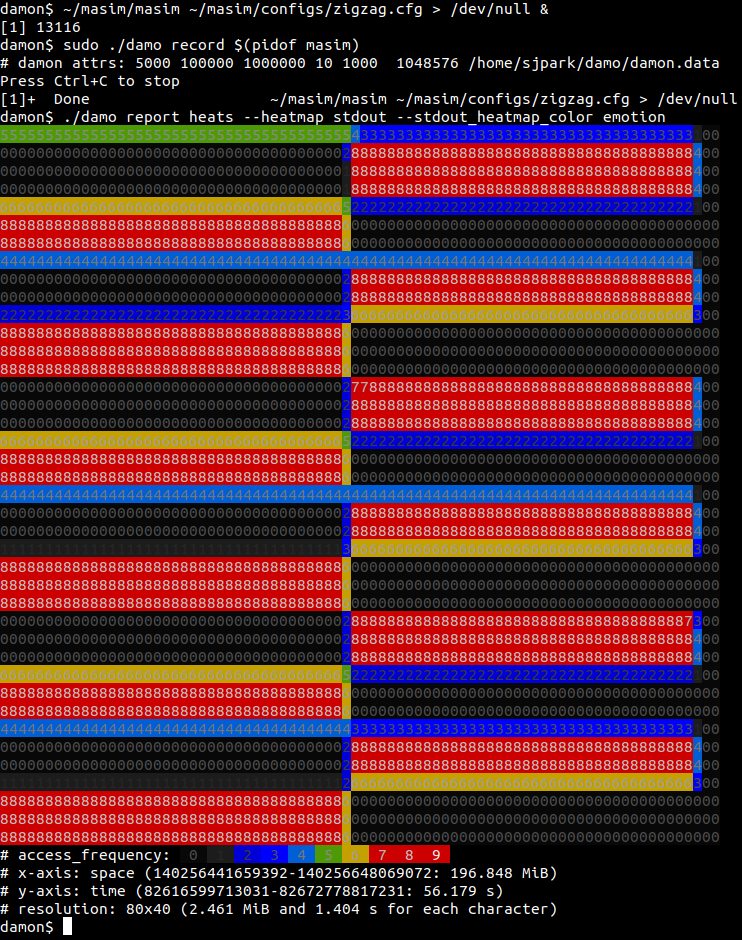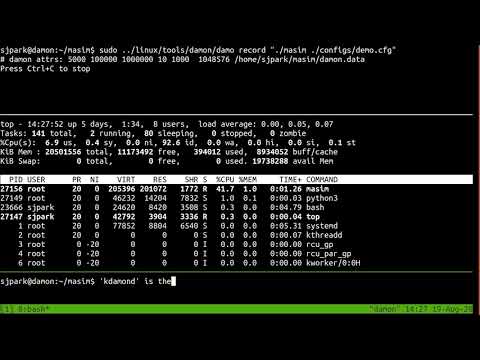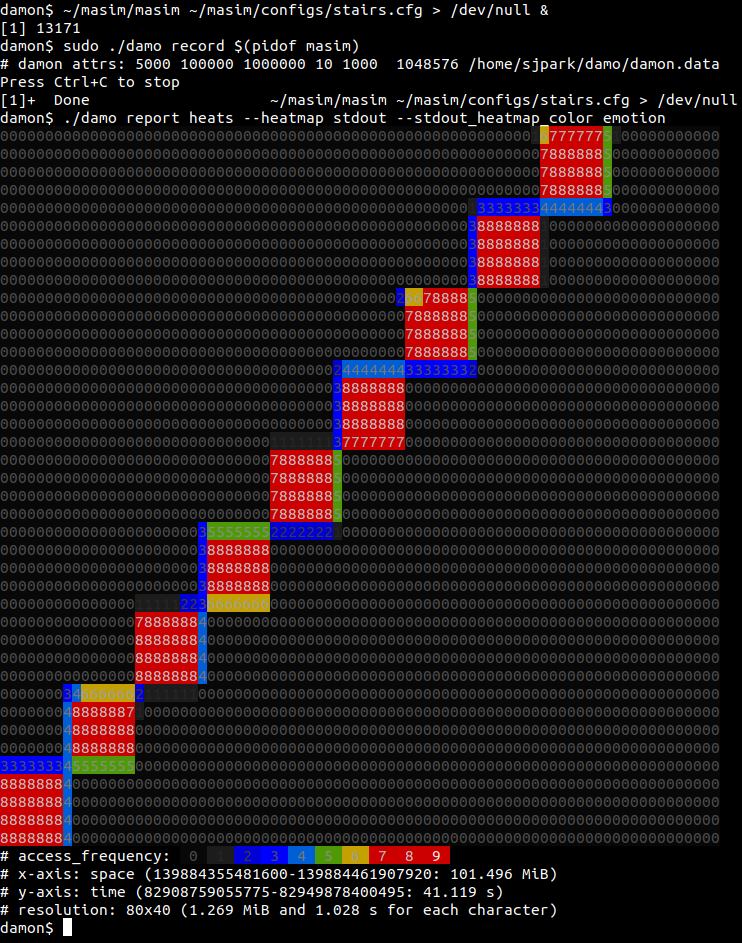DAMON user-space tool
Project description
DAMO: Data Access Monitoring Operator
damo is a user space tool for DAMON. Using
this, you can monitor the data access patterns of your system or workloads and
make data access-aware memory management optimizations.
Demo Video
Please click the below thumbnail to show the short demo video.
Getting Started
Follow below instructions and commands to monitor and visualize the access pattern of your workload.
$ # ensure your kernel is built with CONFIG_DAMON_*=y
$ sudo pip3 install damo
$ sudo damo record $(pidof <your workload>)
$ damo report heats --heatmap stdout --stdout_heatmap_color emotion
The last command will show the access pattern of your workload, like below:

FAQs
How can I install a kernel that is built with CONFIG_DAMON_*=y?
Please refer to 'Install' section of the project webpage.
Where can I get more detailed usage?
The below sections provide quick introductions for damo's major features.
For more detailed usage, please refer to USAGE.md file.
What does the version number mean?
Nothing at all but indicate which version is more fresh. A higher version number means it is more recently released.
Will pip3 install damo install the latest version of damo?
It will install the latest stable version of damo. If you want, you can
also install less stable but more fresh damo from source code. For that,
fetch the next branch of the source tree and use damo executable file in
the tree.
$ git clone https://github.com/awslabs/damo -b next
How can I participate in the development of damo?
Please refer to CONTRIBUTING file.
Why some subcommands are not documented on USAGE.md file?
Only sufficiently stabilized features are documented there. In other words, any feature that not documented on USAGE.md are in experimental stage. Such experimental features could be deprecated and removed without any notice and grace priods. The documented features could also be deprecated, but those will provide some notification and grace periods.
Recording Data Access Patterns
Below commands record memory access patterns of a program and save the
monitoring results in damon.data file.
$ git clone https://github.com/sjp38/masim
$ cd masim; make; ./masim ./configs/zigzag.cfg &
$ sudo damo record -o damon.data $(pidof masim)
The first two lines of the commands get an artificial memory access generator
program and run it in the background. It will repeatedly access two 100
MiB-sized memory regions one by one. You can substitute this with your real
workload. The last line asks damo to record the access pattern in
damon.data file.
Visualizing Recorded Patterns
Below three commands visualize the recorded access patterns into three image files.
$ damo report heats --heatmap access_pattern_heatmap.png
$ damo report wss --range 0 101 1 --plot wss_dist.png
$ damo report wss --range 0 101 1 --sortby time --plot wss_chron_change.png
access_pattern_heatmap.pngwill show the data access pattern in a heatmap, which shows when (x-axis) what memory region (y-axis) is how frequently accessed (color).wss_dist.pngwill show the distribution of the working set size.wss_chron_change.pngwill show how the working set size has chronologically changed.
You can show the images on a web page [1]. Those made with other realistic workloads are also available [2,3,4].
[1] https://damonitor.github.io/doc/html/latest/admin-guide/mm/damon/start.html#visualizing-recorded-patterns
[2] https://damonitor.github.io/test/result/visual/latest/rec.heatmap.1.png.html
[3] https://damonitor.github.io/test/result/visual/latest/rec.wss_sz.png.html
[4] https://damonitor.github.io/test/result/visual/latest/rec.wss_time.png.html
Data Access Pattern Aware Memory Management
Below three commands make every memory region of size >=4K that hasn't accessed for >=60 seconds in your workload to be swapped out. By doing this, you can make your workload more memory efficient with only a modest performance overhead.
$ sudo damo schemes --damos_access_rate 0 0 --damos_sz_region 4K max \
--damos_age 60s max --damos_action pageout \
<pid of your workload>
Deprecated, or Will be Deprecated Features
Below are features that recently deprecated, or will be deprecated. If you depend on any of those, please report your usecase to the community via github issue, sj@kernel.org, damon@lists.linux.dev, and/or linux-mm@kvack.org.
DAMON record binary format
Will be deprecated by 2023 Q3.
At the beginning, DAMO used its special binary format, namely record. It is
designed for lightweight saving of the monitoring results. It is difficult to
read, and not that efficient compared to fancy compression techniques. json
based monitoring results can be easier to read, and more efficient when
compression technique is used. Hence, the format will be deprecated. You may
use damo convert_record_format to convert your old record binary format
monitoring results files to the new format.
`Python2 support
Deprecated. Use Python3.
For some old distros, DAMO initially supported Python2. Because Python2 is really old now, the support has deprecated. Please use Python3 or newer.
DAMOS singline format
Deprecated. Use --damos_* command line options or json format input.
One-line scheme specification format like below was initially supported.
Because it is not flexible for extension of features, it has deprecated now.
You may use --damos_* command line options or json format instead. You may
use damo translate_damos to convert your old single line DAMOS schemes
specification to the new json format.
--rbuf option of damo record
Deprecated.
Early versions of DAMON supported in-kernel direct monitoring results record file generation. To control the overhead of it, DAMO allowed user to specify the size of buffer for the work. The feature has not merged into the mainline, and discarded. Hence the option was available for only few kernels that ported the feature. For most of kernels, tracepoint based record file generation is being used, and the overhead of the approach is subtle. Hence, the option has deprecated.
Project details
Release history Release notifications | RSS feed
Download files
Download the file for your platform. If you're not sure which to choose, learn more about installing packages.














